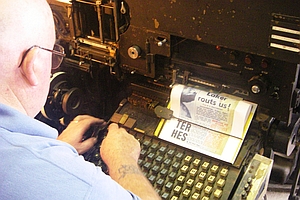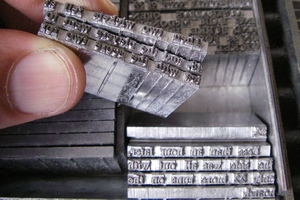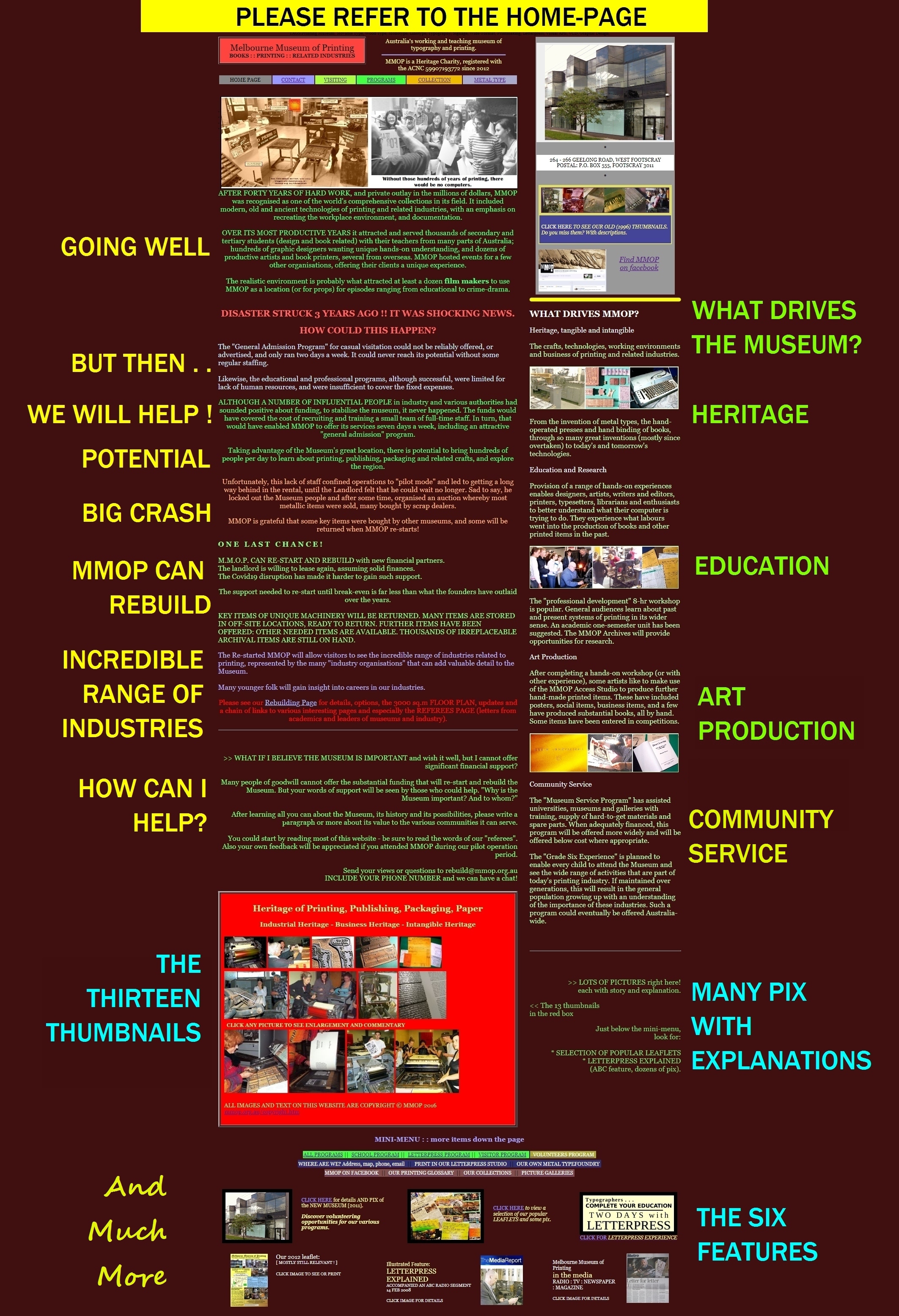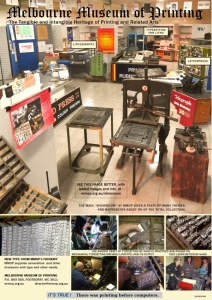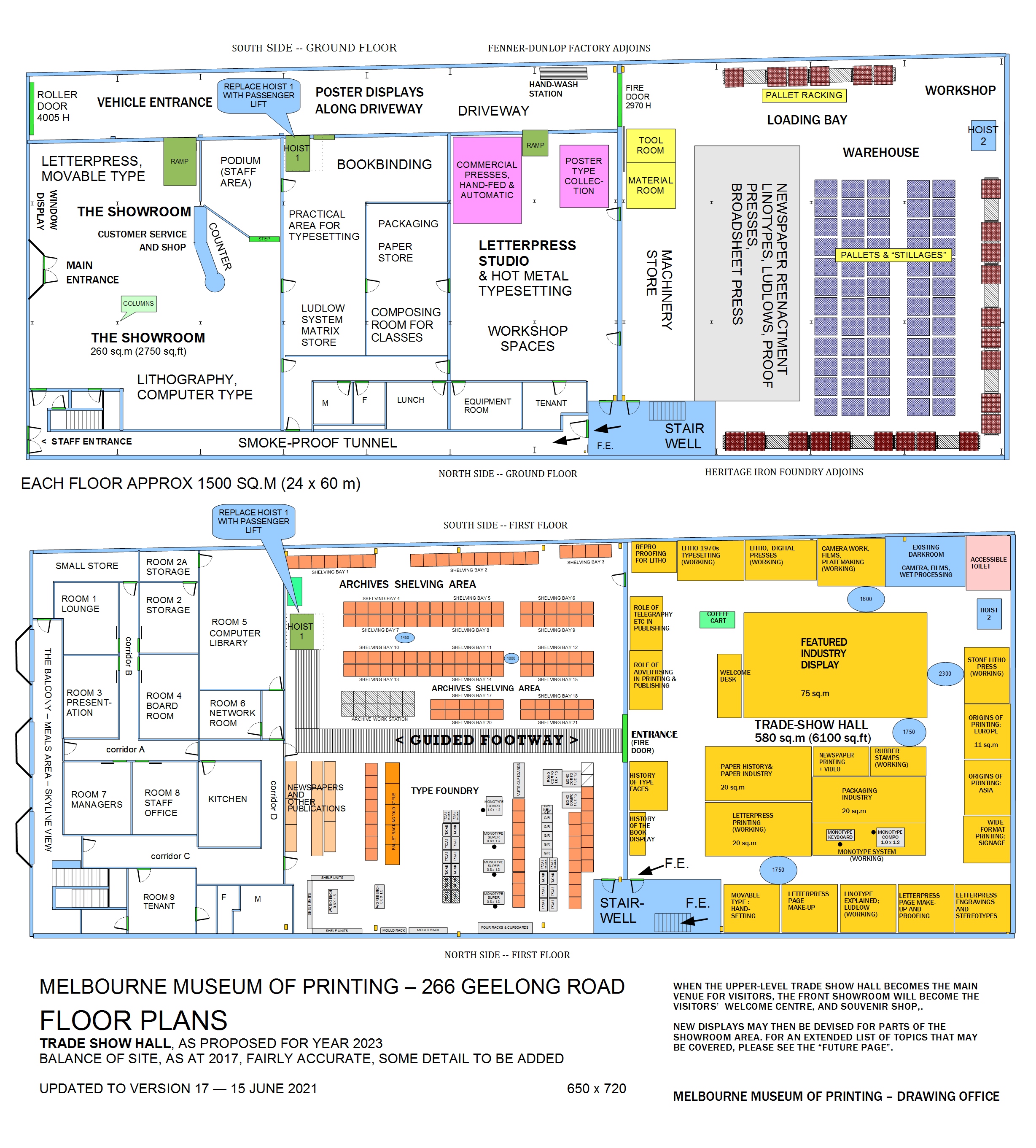The plan, for some years, was to get introduced to those who are known to support art, heritage and education. Michael admits he was a bit shy to talk about his own contributions, and seemed to have no way to ask for help from people who did not know him.
Michael Isaachsen continues and summarises:
So What Happens Next?
This depends on whether we can obtain sufficient financial support to remain at Geelong Road, or only enough to cover a smaller place plus the cost of moving, or only enough for a storage company where we may or may not have enough space to squeeze everything in, or nothing.
In case we have to leave Geelong Road, and we cannot pay for a reasonable place to start again, I would like help to find a business person who could be ready to provide at least a modest space, and help with transport.
Fulfilling the MMOP Budget
Now I must ask you, friends of the Museum, to find PHILANTHROPIC PEOPLE (or broad-minded investors) who are interested in supporting "heritage, education, art production and community service" and find a way to approach them.
If you have someone in mind that you could approach, I could offer you some further information that help you to open a conversation about the Museum, its potential and its history, especially its financial history.
Please ask them to ALLOW ME TO MAKE THE CASE for Australia to have a comprehensive Museum of Printing. This is now a priority. And an urgent one it is.
I realise that being allowed to make my case to such a person is not a guarantee of success. But any such conversation, even if unsuccessful, will educate me about how to improve my presentation. But I feel that I cannot introduce myself.
You may not be aware, but someone among your acquaintances, with "a bit of clout", may know a person or company who would be willing and able to help (or at least discuss it), if only they knew about MMOP, its history, its challenges and its potential. Some philanthropists are interested in "heritage, art-production and education".
It's not only "print people" who value the preservation of all this knowledge and artefacts. Printing has in some way benefited every branch of knowledge and endeavour, and people in many walks of life appreciate that.
There may even be some people who would be moved to support when they learn of my own efforts and commitment over forty years since 1977. My family and I have reached the end of our own finance - we have no more to give. My family have surrendered all their assets including their houses. They shared with me an expectation that industry, government and philanthropy would continue, now that I cannot.
I am not asking you to negotiate, but to inform someone who might help, perhaps indirectly, that such a museum is of value to the community, and that you believe that I need a chance to show them how it will become self-supporting and able to pay its way. Please break the ice, introduce me to someone I would not otherwise get to talk to. It could be a sponsor, donor or lending organisation, a government person, educator or just one of those good-timers who know lots of people.
Since the surrender of the family's assets, and the sale of the machinery, the money needed for re-starting the Museum is a lot less, but still out of reach for most individuals. I can just say here that the amounts needed to cover expenses until the break-even is far less than the amounts that my family and I have already contributed.
The alternative, of buying the building, is of course far preferable for the Museum's long-term prospects, because leasing is unlikely to be permanent. The cost of purchase goes well outside those figures. If someone buys it and rents to the Museum, or provides funds for the Museum to buy it, either way, there would be protection in the contract for that party if the Museum ceases to operate.
GOVERNANCE
It is relevant, here, to mention the "Corporate" plans. An experienced Not-For-Profit law firm will set up the two planned bodies to manage the Museum and its assets. An initial tranche of funds will be requested, to cover these expenses.
The current plan (subject to legal advice) is that the Museum will become an Incorporated Association, and the MMOP Foundation Inc will be set up to own the heritage assets and manage all donations and loan funds. Both will qualify for "DGR Status", so permitting tax deductions by donors.
The Foundation will consist of a small team of legal, accounting and professional people most of whom are not involved in MMOP management. The two bodies' constitutions will be linked so the Foundation can oversight the management of the Museum and its Committee. A key role will be to ensure that any loan obligations are fully complied with.
It is my belief that a core team of up to six staff will give the ideal outcome, recruited over the first few years and taking the Museum to reliable full-time operation, with reliable, meaningful services and substantial revenues.
EVENTUAL HANDOVER
I do not intend to continue to manage the Museum for much longer. I hope to have a good team in place and a great "membership organisation" and board to manage the venture within a reasonable time, and hand the task over to them.
The budget assumes that a salaried Director will be required at that time.
THE TRAINED, LONG-TERM TEAM IS ESSENTIAL
The team wages will be the largest item within fixed expenditure, and the team's efforts will be responsible for most of the revenue, as they will deliver the core programs and the marketing efforts.
Volunteers will continue to play a part, trained and encouraged by the team, they will play the major role in cataloguing and curatorial work on the thousands of books, artefacts, typefaces, spare parts and machinery. It is also likely that among the volunteers will be some who can impart relevant knowledge to the Team.
The most critical role for the team, a role which might not work so well with a smaller team, is to comprise an ongoing human-based store of knowledge about the main focus of the Museum. That is, the crafts and business of printing and related industries, including the Ancient Crafts of typefounding, typesetting, printing by hand, and bookbinding. When a new member is recruited, the others will pass on those ancient crafts to them at a measured pace.
They will be encouraged and assisted to visit other related organisations to gain context and additional skills, and that may become a two-way street.
The Team will also host and offer training to volunteers from other museums which may have lost their older, experienced, people.
THE ROLE OF INDUSTRY ORGANISATIONS
Many parts of the "wider" industry (e.g. publishing, packaging, advertising, signage, labelling, suppliers of goods and services) have their own specialised organisations to support their operations. In time, all of these will be invited to take part in MMOP activities, providing their particular understandings to the wider industry, and the general public.
ARCHIVES AND LIBRARIES
I have been advised by some people who love those ancient crafts, that a lot of our 'archival material' is of little value and it should not take up floor space. But others, including members of professional bodies, librarians and historians, advise me that such material is of value for research. I understand that archives cannot generate much cash-flow, if any, but they fulfil an important role.
Archives of trades are of greater value to a researcher if knowledgeable staff are on hand to provide background and interpretation. Accordingly I believe that archives would be of greatest benefit if they remain within a substantial, relevant organisation that can give context to the items. That will fulfill the intention of the providers of the archives.
In a way, our 'type foundry' is like that. Using the Monotype system, it makes and supplies founts of movable type for universities, museums (including MMOP) and small printeries, and it can also compose type from a keyboard, e.g. for a book.
When the foundry is again operational, it will provide a captivating experience for many visitors. The Monotype was the major system of typesetting for publishers of quality books and journals from around 1900 to the late 20th century.
But at likely volumes the foundry might not survive as an independent operation.
That's about it. Please email me for any further information to offer your comments or ask questions. Please include your phone number and we can have a chat.
Michael
rebuild@mmop.org.au
| 